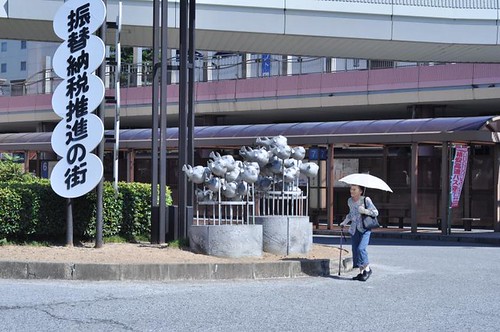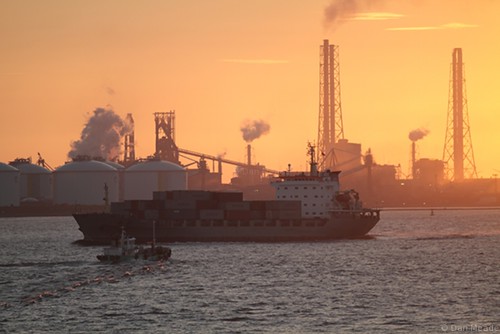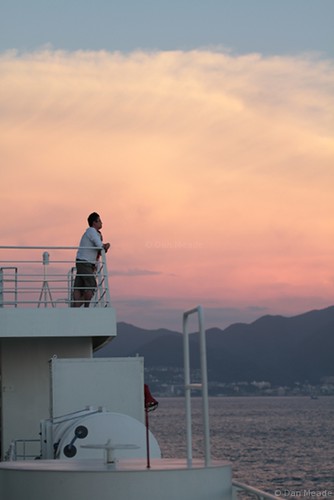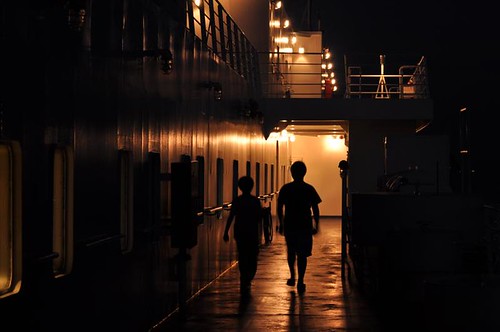![]() Sitting in Hiroshima Station at lunchtime, watching our okonomiyaki cook on the griddle, the sense of constant departure, or of constantly departing, was both palpable and welcome. Here we were, waiting for some dude with a spatula to cook up squid, shrimp, octopus, and other assorted sea objects with batter, cabbage, and sweet sauce, and we already needed to be in Korea. In many ways that was a world away. And, in order to get there, we’d need to take a fast train to a slow train to an even slower boat.
Sitting in Hiroshima Station at lunchtime, watching our okonomiyaki cook on the griddle, the sense of constant departure, or of constantly departing, was both palpable and welcome. Here we were, waiting for some dude with a spatula to cook up squid, shrimp, octopus, and other assorted sea objects with batter, cabbage, and sweet sauce, and we already needed to be in Korea. In many ways that was a world away. And, in order to get there, we’d need to take a fast train to a slow train to an even slower boat.
 After paying our bill, we boarded the Shinkansen and rocketed, as had become the norm, through mountains and valleys, compressed downtowns and bucolic agricultural scenes. Every once in a while, we could see the beginnings of suburban encroachment onto farmland, with occasional Long Island-looking homes sprouting up among traditional, tile-roofed ones. At Shin-Shimonoseki Station, we made a one-minute transfer to a train headed for Regular Shimonoseki Station, at the end of the line. The second train was an old, two-car clunker, full of schoolchildren and an angry-looking conductor.
After paying our bill, we boarded the Shinkansen and rocketed, as had become the norm, through mountains and valleys, compressed downtowns and bucolic agricultural scenes. Every once in a while, we could see the beginnings of suburban encroachment onto farmland, with occasional Long Island-looking homes sprouting up among traditional, tile-roofed ones. At Shin-Shimonoseki Station, we made a one-minute transfer to a train headed for Regular Shimonoseki Station, at the end of the line. The second train was an old, two-car clunker, full of schoolchildren and an angry-looking conductor.

When we arrived at the very quiet city center, which seemed to consist solely of a mall, a tall building with a ball-shaped top, and some pedestrian bridges, we didn’t realize just how close we were to the boat that would usher us to the next phase of Manic Asia.
Now, about that boat. The travel guidebooks had said there was a ferry from one country to the other, and that it was a cheap way to make the crossing overnight. It went from tiny Shimonoseki, Japan to bustling Busan, South Korea. That’s all we found in print. The ferry website was in Japanese, but even when translated, it was beyond cryptic and offered no way to buy tickets. Internet message boards suggested that booking the ferry was difficult, impossible in America, impossible even in Tokyo. In fact, the Internet said that you had to find an English-speaking travel agent in Osaka, the nearest large city to Shimonoseki, and try to make arrangements there. However, since we didn’t want to arrive in any of these cities only to learn that the ferry was sold out, that wasn’t good enough for us.

So we emailed the ferry company, in English. And we were shocked when we got an instantaneous response, giving the rates, reservation policies, and a list of information we would have to provide.
“Please teach the use class,” the email said. “All members are necessary.”
We replied with our info and received a confirmation number. The ferry staff explained that we could pay our fare on arrival with a credit card, but “only the cash payment” would be accepted for the port fees. We’d booked the Kampu Ferry! Now, all we needed was to get to Japan. And, more specifically, to Shimonoseki.
Shimonoseki is a small port city in western Japan, located on the Sea of Japan, or the East Sea, depending on whom you ask. Tour books portray it as “gritty” and “industrial;” these places are seemingly a hallmark of every Manic trip (see also: Wichita, Marquette, Algeciras, etc…). Shimonoseki happens to be the hub for catching fugu, a partially edible pufferfish that contains a serious nerve toxin. When improperly prepared, it occasionally (and sometimes famously) kills a diner.

Avoiding this truly local fare, we ate fast-food burgers, having ordered by pointing at the menu boards, and then checked in at the ferry terminal, laying down our cash and credit payments. The ship, the m/v Hamayuu, sat at the berth for hours, and so did we. As we waited, tour buses dropped off loads of apparently Korean ladies carrying shopping bags.
Suddenly an announcement in Japanese called the ferry-boarders to attention. It was repeated in Korean. 300 or so people formed a line. We looked around to see if anyone could translate for us. No such luck. In fact, for the first time on the trip, we couldn’t spot a single non-Asian. So we got in line, nervously playing (or more so being) dumb, got our passports stamped, and boarded the Hamayuu. On the ship, a pleasant agent handed us the keys to our cabin, a tiny room with bunk beds, shower, and even a pot of hot water. We made green tea as we waited for departure time, and then we took to the top deck with our camera gear.
The departure from Shimonoseki was possibly the most dramatic leaving of any place I’ve experienced to date. With a long blast of the whistle, the ship heaved itself into the channel and turned hard west, pursuing the burning sunset as it navigated its way toward the open sea. We passed by little ports and grain elevators and refrigerated warehouses, resplendent in the golden-hour light. The giant, globular sun burned with orange-red ferocity behind coal piles and industrial plants that belched backlit columns of steam and heat into the haze. And then it was dark.
The Hamayuu continued to snake between myriad anchored cargo ships, their cabin lights illuminated and strangely lifelike compared to their inert, silhouetted, and enormous hulls. Above us on another deck, a woman sang into the wind. Children played with their brothers and sisters, running in circles on the spotlessly painted decks. Below us, the saltwater churned; above us, the smokestack hummed loudly at the moon.

We were hungry. We descended to the Engrish-labeled “PROMENARD DECK” and attempted to eat in the cafeteria, where one needed to purchase a ticket for a specific meal item before entering. The ticket vending machine was labeled only in Japanese and Korean, though the menu was illustrated and featured a picture of an American breakfast. A young attendant, who bashfully and emphatically apologized for his imperfect English, helped us buy tickets for Bibimbap, one of the few meal choices left. The food was surprisingly good, and we washed it down with two large Kirins. After a quick but memorable stop in the duty free shop — where the attendant asked us if we were Japanese — we headed back to our bunks. The ship would arrive in Busan, South Korea sometime between 6 and 8 am, and we wanted to be awake to shoot the trip through busy Busan harbor.
The story continues: The Mysteries of the Kampu Ferry, Part II: Entering South Korea
See the full photo gallery on Flickr:

Essay by Rob Bellinger
Photos by Rob Bellinger & Dan Meade
Date of voyage: 7/23/10
Date of Publication: 9/19/11